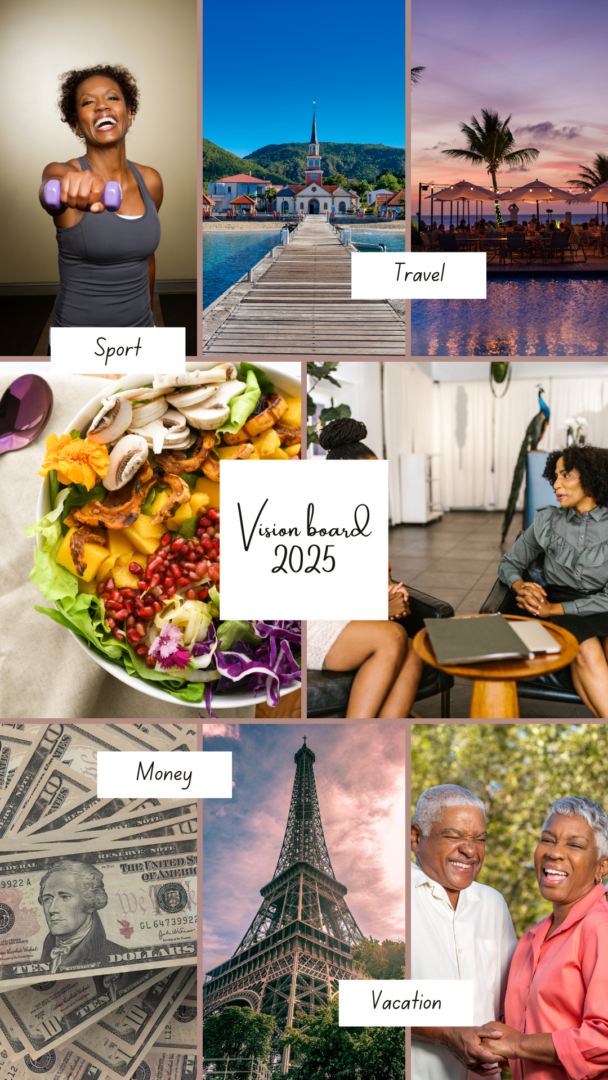

Vision Boards That Go Beyond the Pretty
Let’s be real: vision boards get a lot of hype. Some see them as magical tools for manifesting their dream life, while others dismiss them as Pinterest projects on steroids. The truth lies somewhere in between. Done right, vision boards are powerful tools for crafting a roadmap that aligns your goals across every aspect of your life.
And that’s where the concept of “parallel paths” comes in. For most of us, life isn’t a straight road; it’s a web of interconnected priorities—career, health, relationships, personal growth, and more. It’s not about picking one path and ignoring the others; it’s about ensuring all your paths work together in harmony.
So, forget the superficial “just slap on some pretty pictures” approach. This is about building a vision board with substance. One that aligns with your values, reflects your depth, and keeps you moving forward, no matter how complex your aspirations may be. Ready to create a vision board that works? Let’s dive in.
Why Vision Boards Are So Popular (and Why They Work)
Vision boards are having a moment (lol, aren’t we all) , and it’s not just because they’re fun to create. Here’s why they’ve become such a powerful tool for goal-setting and personal growth:
- They Harness the Power of Visualization
Science backs this up: visualizing your goals activates your brain’s reticular activating system (RAS), helping you stay focused on opportunities that align with your intentions. Think of it as priming your brain to spot the breadcrumbs that lead to your big dreams. - They’re Intentional and Reflective
The process of creating a vision board forces you to pause and ask: What do I truly want? It’s not just about dreaming; it’s about aligning your dreams with your reality. - They Keep Your Goals Front and Center
Let’s face it: it’s easy to forget your New Year’s resolutions by February. A vision board serves as a visual reminder of your goals, helping you stay motivated and on track. - They Combine Manifestation with Action
Sure, the law of attraction gets all the buzz, but the real magic happens when visualization meets execution. A vision board is only effective if you pair it with concrete, actionable steps.

Parallel Paths: Aligning Every Aspect of Your Life
Vision boards are especially important for “parallel pathers” like you—people balancing multiple, interconnected priorities. Here’s what that looks like in real life:
- Career Path: Whether you’re climbing the corporate ladder, growing a business, or exploring a new role, your professional aspirations often set the tone for everything else.
- Health Path: Your physical and mental well-being are the fuel that powers your other goals.
- Relationships Path: The people in your life—family, friends, mentors—form your support system, which is crucial for success.
- Personal Growth Path: Learning new skills, developing hobbies, or finding ways to express your creativity keeps life exciting and fulfilling.
The key is to align these paths so they complement one another, rather than compete for your time and energy. This is where vision boards shine: they bring clarity, showing you how your goals intersect and support one another.

Parallel Paths: Aligning Every Aspect of Your Life
Vision boards are especially important for “parallel pathers” like you—people balancing multiple, interconnected priorities. Here’s what that looks like in real life:
- Career Path: Whether you’re climbing the corporate ladder, growing a business, or exploring a new role, your professional aspirations often set the tone for everything else.
- Health Path: Your physical and mental well-being are the fuel that powers your other goals.
- Relationships Path: The people in your life—family, friends, mentors—form your support system, which is crucial for success.
- Personal Growth Path: Learning new skills, developing hobbies, or finding ways to express your creativity keeps life exciting and fulfilling.
The key is to align these paths so they complement one another, rather than compete for your time and energy. This is where vision boards shine: they bring clarity, showing you how your goals intersect and support one another.
Steps to Build a Vision Board That Balances Depth and Substance
1. Define Your Focus Areas
Start by identifying the areas of your life you want to focus on. Be honest with yourself:
- Career: Do you want a promotion, a career pivot, or more work-life balance?
- Health: Are you looking to improve your fitness, prioritize self-care, or manage stress?
- Relationships: How can you nurture your connections with family, friends, or a romantic partner?
- Personal Growth: What skills, hobbies, or experiences will help you grow as a person?
For each area, ask:
- What does success look like here?
- Why is this important to me?
- How does this align with my other goals?

2. Gather Inspiration That Goes Beyond Aesthetics
Yes, visuals matter, but this isn’t just about making your board look pretty. Your visuals should evoke emotion and meaning. Here’s how to dig deeper:
- Photos: Choose images that spark specific feelings or memories. For example, a photo of a hiking trail might represent your goal to embrace nature and fitness.
- Quotes: Find affirmations or mantras that resonate with your personal values and drive.
- Symbols and Icons: Use meaningful visuals like a compass for direction or a heart for relationships.
- Personal Mementos: Include photos or items from your life that remind you of past successes.
3. Organize Your Vision Board With Structure
This is where the magic happens—how you arrange your board matters. Here are some ideas:
- Cluster by Themes: Create sections for each focus area (e.g., career, health, relationships).
- Highlight Priorities: Place your most important goals in the center of your board.
- Layer by Timeline: Arrange visuals from short-term to long-term goals if you want a chronological layout.
- Color Coding: Assign colors to each theme for visual clarity.
Pro Tip: If you’re a digital person, apps like Canva or Pinterest can help you create a sleek, virtual version of your board.
4. Pair Each Vision With Tangible Steps
The biggest mistake people make? Stopping at the visualization phase. A vision board with depth includes an action plan for every dream. For example:
- Goal: Run a marathon.
Action: Join a running club and set a training schedule. - Goal: Save for a dream vacation.
Action: Open a savings account and set up automated deposits.
Ask yourself: What’s the first thing I can do to move closer to this goal?
Types of Vision Boards (Because One Size Doesn’t Fit All)
- Traditional Boards: Physical boards with cutouts and photos for hands-on creatives.
- Digital Boards: Perfect for tech-savvy folks who prefer tools like Canva or Pinterest.
- Goal-Oriented Boards: Structured around specific milestones or timelines.
- Thematic Boards: Focused on one area of life, such as career or health.
- Hybrid Boards: Combine multiple styles for parallel pathers balancing diverse goals.
Why Vision Boards Need Substance (Not Just Style)
Sure, a visually appealing board is nice, but what makes a vision board truly effective is substance:
- Values Over Vanity: Focus on what aligns with your core beliefs, not just societal expectations.
- Balance Over Busyness: Avoid creating a board that feels like a chaotic to-do list. Balance is key.
- Action Over Aesthetics: Tie every visual to a specific, actionable step. It’s not just about dreaming—it’s about doing.
The Payoff: A Life Aligned Across Parallel Paths
When your vision board reflects your parallel paths, something incredible happens: life feels purposeful and harmonious. You’re no longer compartmentalizing your goals into isolated boxes. Instead, you’re creating a map that shows how all the pieces of your life fit together. It’s not just a vision—it’s a strategy.

Ready to create a vision board that inspires action? Take your time to dig deep, align your parallel paths, and build something meaningful. Share your vision board with us using #AlignedVision2025—we’d love to see how you’re crafting your dream year!

